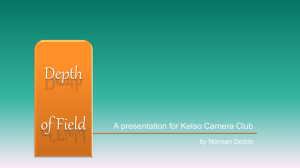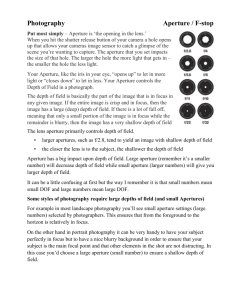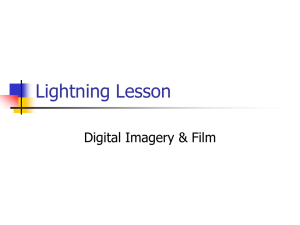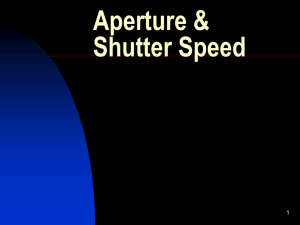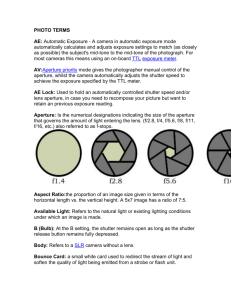Aperture - Hillcrest Camera Club
advertisement
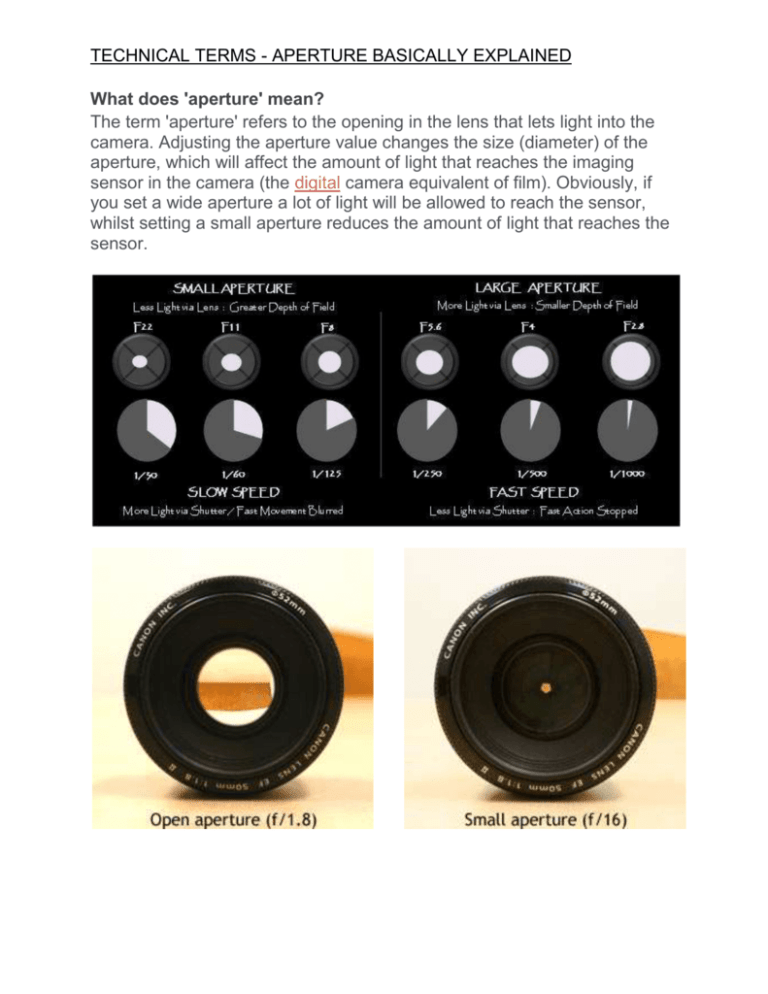
TECHNICAL TERMS - APERTURE BASICALLY EXPLAINED What does 'aperture' mean? The term 'aperture' refers to the opening in the lens that lets light into the camera. Adjusting the aperture value changes the size (diameter) of the aperture, which will affect the amount of light that reaches the imaging sensor in the camera (the digital camera equivalent of film). Obviously, if you set a wide aperture a lot of light will be allowed to reach the sensor, whilst setting a small aperture reduces the amount of light that reaches the sensor. Measuring Aperture Size Aperture size is represented using f-numbers. A large f-number represents a small aperture - the lens will have a small opening and not let much light through to the imaging sensor. A small f-number represents a wide aperture - the lens will have a large opening and therefore let a lot of light through to the imaging sensor. This is the case because f-numbers represent the ratio between the diameter of the aperture and the focal length of the lens. As an example: if the aperture value is shown as f/4 this means that the aperture's diameter is 1/4 (25%) of the focal length of the lens if the aperture value is f/32, the aperture's diameter will be 1/32th of the focal length of the lens - a much smaller diameter than the 1/4 size. Large aperture, background out of focus; = smaller f-number Small aperture, everything in focus = larger f-number Now, lets get on to why this matters and how it can change what your picture looks like. Basically, a larger aperture (lower f/number) will have your subject in focus, and everything in front of and behind it blurry – a shallow depth of field Take a look at the following diagram; the further apart the lines are, the more out of focus something is: Large aperture (f/1.8). A smaller aperture will have your subject in focus and everything in front of and behind it quite focused as well therefore a greater depth of field. Small aperture (f/16). Shutter Speed Shutter speed is a much simpler concept to understand. It's basically how long the sensor/film in the camera is exposed to light. How long the shutter stays open depends on how much light there is. For pictures with the same aperture setting, if the is shutter open too long, the picture will be too bright, and if it's not open long enough, the scene will be too dark. Therefore, you control the overall exposure (lightness and darkness) of the scene with both the aperture and shutter speed control. The shutter speed is the other (usually larger) number that isn't the aperture value. This number is actually a fraction, so if you see a shutter speed of 4000, it's actually 1/4000th of a second, while a value of 200 is 1/200th of a second. By halving the time of exposure, you're letting in half the amount of light (so if you go from 1/2000 sec to 1/4000 sec, then you're letting in half the light). The opposite is true for doubling the exposure time. What you can do with shutter speed is freeze motion with a fast shutter speed or capture movement with a slow shutter speed. Flowing water looks silky smooth at speeds slower than 1/8th of a second (with a tripod), while you can freeze water in time with fast shutter speeds. The same thing goes for hip hop dancers. Also, an important side note is that there is a rule for getting sharp images: 1/focal length. So if you have a 50mm lens then you'd need at least 1/50th of a second for your picture to not be blurry, and if you're using a digital SLR then there is a crop value (minus a few exceptions) of 1.5/1.6 so your 50mm lens is a 75~80mm lens, which means that you need a shutter speed of at least 1/80th of a second to get a sharp image. Summary: Fast shutter speed = freeze action. Slow shutter speed (w/ tripod) = silky flowing water. How Aperture and Shutter Speed are Related Aperture and shutter speed are bound together like an old married couple. For the same scene, if you open the aperture, you increase the shutter speed, and if you close down the aperture, you decrease the shutter speed. Think of a bucket of water with a hole in the bottom. If you have a large hole in the bottom of the bucket (large aperture), water will drain out quickly (fast shutter speed). Conversely, for the same amount of water, if you have a small hole in the bottom of the bucket (small aperture), the water will drain out slowly (slow shutter speed). One aperture stop is equivalent to one shutter speed stop, therefore if you open up your aperture one stop brighter (say from f/8 to f/5.6), and increased your shutter speed to one stop darker (like 1/250 to 1/500), then you would get the same exposure. So f/8 @ 1/250 is equivalent to f/5.6 at 1/500. This is the theory of equivalent exposures. Summary: Larger aperture, faster shutter speed; Smaller aperture, slower shutter speed. Increase aperture by one stop and decrease shutter speed by one stop = equivalent exposure (and vice versa).


